Barbell exercises are some of the most versatile and effective strength training tools for working major muscle groups like arms, shoulders, back, chest, core, and legs.
Barbell training develops raw power, increases metabolism, burns fat, and builds an athletic, muscular physique.
With just a barbell and weight plates, you can sculpt your ideal physique in the gym or even at home.
This guide will provide you with an overview of over 100 of the best barbell exercises to target each muscle group for beginners to advanced fitness levels.
With clear images and easy-to-follow instructions, you’ll learn proper lifting form and techniques to maximize results safely.
Save or bookmark this illustrated barbell workout guide.

- Barbell Chest Exercises Names
- 1. Barbell Bench Press
- 2. Incline Bench Press
- 3. Decline Bench Press
- 4. Reverse Grip Press
- 5. Barbell Pullover
- 6. Close-Grip Bench Press
- 7. Incline Reverse Grip Bench Press
- 8. Landmine Chest Press
- 9. Wide-Grip Barbell Bench Press
- 10. Barbell Floor Press
- 11. Barbell Guillotine Press
- 12. Bench Pin Press
- 13. Barbell Board Press
- 14. Spoto Press
- 15. Landmine Floor One Arm Chest Fly
- Barbell Back Exercises Names
- 1. Deadlift
- 2. Bent Over Barbell Rows
- 3. Landmine Row
- 4. Standing Barbell Rear Delt Row
- 5. Barbell Upright Row
- 6. Barbell Chest Supported Row
- 7. Barbell Shrug
- 8. Barbell Good Morning
- 9. Landmine Deadlift
- 10. Seal Row (Flat Bench Row)
- 11. Meadows Row
- 12. Barbell Hip Bridge
- 13. Clean And Jerk
- 14. Pendlay Row
- 15. Rack Pull
- 16. Barbell High Pull
- 17. Snatch Grip Deadlift
- Barbell Shoulder Exercises Names
- 1. Military Press
- 2. Seated Barbell Overhead Press
- 3. Barbell Front Raise
- 4. Behind-The-Neck Press
- 5. Barbell Lying Rear Delt Row
- 6. Standing Barbell Rear Delt Row
- 7. Bradford Press
- 8. Standing Wide Grip Shoulder Press
- 9. Close Grip Military Press
- 10. Single Arm Landmine Shoulder Press
- 11. Barbell Z Press
- 12. Barbell Split Jerk
- 13. Incline Barbell Front Raise
- 14. Wide Grip Barbell Upright Row
- Barbell Bicep Exercises Names
- 1. Barbell Bicep Curl
- 2. Barbell Preacher Curl
- 3. Barbell Spider Curl
- 4. Barbell Drag Curl
- 5. EZ Bar Curl
- 6. Barbell Reverse Curl
- 7. Barbell Hammer Curl
- 8. EZ Bar Seated Concentration Curl
- 9. EZ Bar Reverse Grip Preacher Curl
- 10. Close Grip Barbell Curl
- 11. Wide Grip Ez Bar Curl
- 12. Standing Barbell Preacher Curl
- 13. 21s Barbell Bicep Curl
- 14. Barbell Curl On An Arm Blaster
- Barbell Tricep Exercises Names
- 1. Lying Barbell Triceps Extension
- 2. Overhead Barbell Triceps Extension
- 3. Close-Grip Bench Press
- 4. Incline Barbell Tricep Extension
- 5. Decline Barbell Tricep Extension
- 6. Reverse Grip Skull Crusher
- 7. Reverse Grip Barbell Press
- 8. Barbell JM Press
- 9. Incline Close Grip Bench Press
- Barbell Leg Exercises Names
- 1. Barbell Squat
- 2. Barbell Lunges
- 3. Barbell Front Squat
- 4. Stiff-Leg Deadlift
- 5. Landmine Deadlift
- 6. Zercher Squat
- 7. Barbell Step Up
- 8. Side Lunge
- 9. Jefferson Squat
- 10. Barbell Lunges
- 11. Barbell Hip Thrust
- 12. Barbell Box Squat
- 13. Landmine Squat
- 14. Landmine Hack Squat
- 15. Landmine Sumo Squat
- 16. Barbell Standing Calf Raise
- 17. Barbell Seated Calf Raise
- 18. Barbell Hack Squats
- Barbell Abs and Core Exercises Names
- 1. Barbell Rollout
- 2. Landmine Twists
- 3. Standing Barbell Twist
- 4. Barbell Side Bend
- 5. Overhead Barbell Side Bend
- 6. Barbell Sit Up
- 7. Barbell Suitcase Carry
- Conclusion
Barbell Chest Exercises Names
A muscular, well-defined chest is a hallmark of a strong, aesthetic physique. Barbell chest exercises barbell lets you lift heavy and build serious strength and muscle mass in your chest.
This section will include over 15 exercises for the chest with barbells that are very popular. Each exercise will have descriptions and pictures to help you understand them.
1. Barbell Bench Press
The barbell bench press is a classic chest exercise that is widely used in weight-lifting circles. It is a compound exercise that simultaneously works for multiple muscle groups.
It primarily targets the pectoral muscles (chest) but also engages your shoulders, triceps, and even your core to some extent.
It is the fundamental exercise for the upper body and should be a part of any best chest exercise regime.

2. Incline Bench Press
The Incline barbell chest Press is a version of the traditional bench press in which the bench is positioned at about a 30-45 degree angle.
The Incline Bench Press exercise focuses on the upper chest and helps build a massive chest. The incline angle also allows for greater activation of the anterior deltoids (front shoulder muscles).
The study found that the most activity for the upper part of the pectoralis major muscle occurred when the bench was angled at 30 degrees.

3. Decline Bench Press
The barbell decline bench press is excellent for strengthening your lower chest muscles.
In a decline chest press, the bench is set to 15 to 30 degrees on a decline. This angle places your upper body on a downward slope, which activates the lower pectoral muscles as you push weights away from your body.
The decline angle reduces the stress on the shoulders, reduces the risk of shoulder strain, and allows you to lift heavier weights.
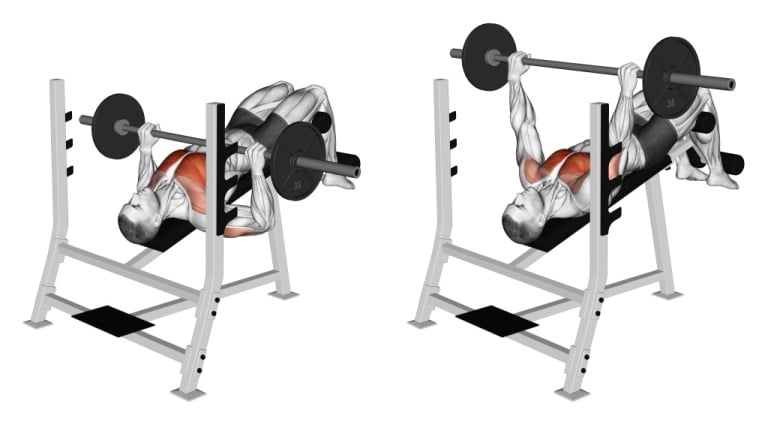
4. Reverse Grip Press
This simple and highly effective shoulder-friendly pressing variation helps to build mass and strength in your chest and triceps.
The reverse grip bench press is a traditional bench press exercise variation. It primarily targets the muscles of the chest, with a particular focus on the upper pectoral muscles.
This exercise also engages the triceps and the anterior deltoids (front part of the shoulders) more intensely than the standard bench press.
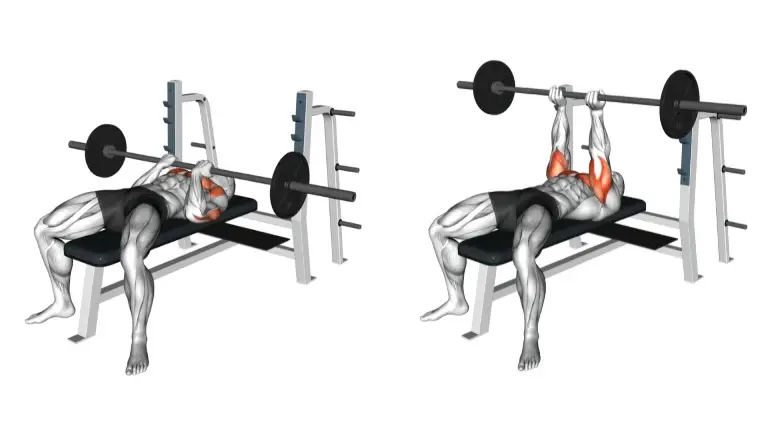
5. Barbell Pullover
If you’re looking for a way to get more creative with your barbell chest workout, why not try a barbell pullover exercise?
The barbell pullover is a compound exercise that simultaneously works for multiple muscle groups. It helps to build a strong rib cage and serratus anterior muscle to build a complete chest and back.
When done correctly, it also helps to increase flexibility and range of motion in the chest and shoulders.

6. Close-Grip Bench Press
The close grip bench press is a variation of the bench press and an exercise used to build muscle and strength in the triceps.
Unlike the traditional bench press, which primarily targets the chest muscles, the close grip version focuses more on the triceps and the inner chest.

7. Incline Reverse Grip Bench Press
The incline reverse-grip bench press is a variation of the traditional bench press that targets the upper chest muscles more effectively.
You can do it by lying on an incline bench (usually set at an angle of 30–45 degrees) and gripping the barbell with an underhand grip.
Some people found that using the reverse grip can reduce stress on their shoulders compared to using the regular grip.
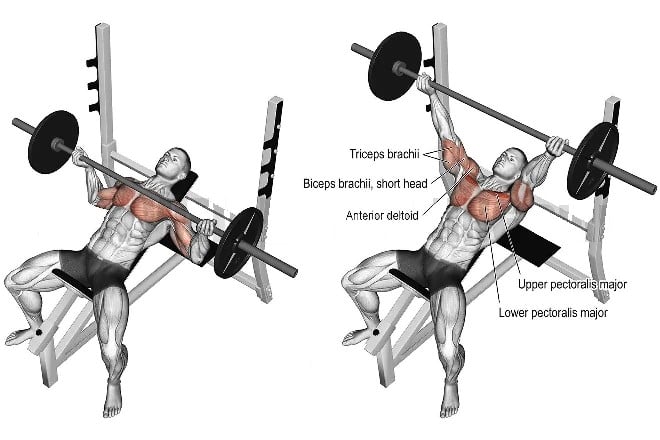
8. Landmine Chest Press
If you’re looking for a way to get more creative with your inner chest workout, why not try the Landmine barbell chest press exercise?
The angled path of the barbell puts less strain on the shoulder joints.
The landmine chest press can be modified in various ways (like changing the grip, stance, or adding movements) to target different muscle groups.
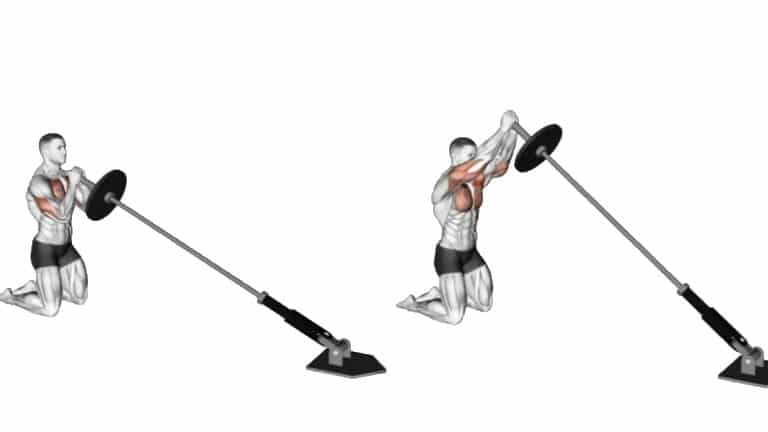
9. Wide-Grip Barbell Bench Press
The Wide-grip barbell bench press is a variation of the traditional bench press wherein the hands are placed further apart on the barbell.
- Hands placed a hand’s width or more outside shoulder-width on the barbell.
- Focuses on the outer pecs and shoulders more than a regular grip.
Note: For some, the wider grip reduces strain on the shoulder joints compared to a narrower grip.
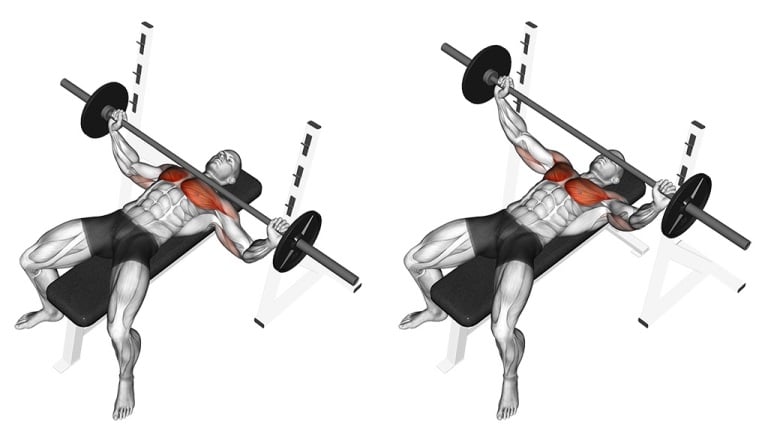
10. Barbell Floor Press
You can do a Barbell Floor Press by lying on the floor instead of on a bench. This exercise primarily targets the muscles of the chest, triceps, and shoulders.
The floor press emphasizes the upper chest and triceps more than a regular bench press, thanks to the shorter range of motion.
The floor limits how far you can lower the barbell, which reduces shoulder strain.
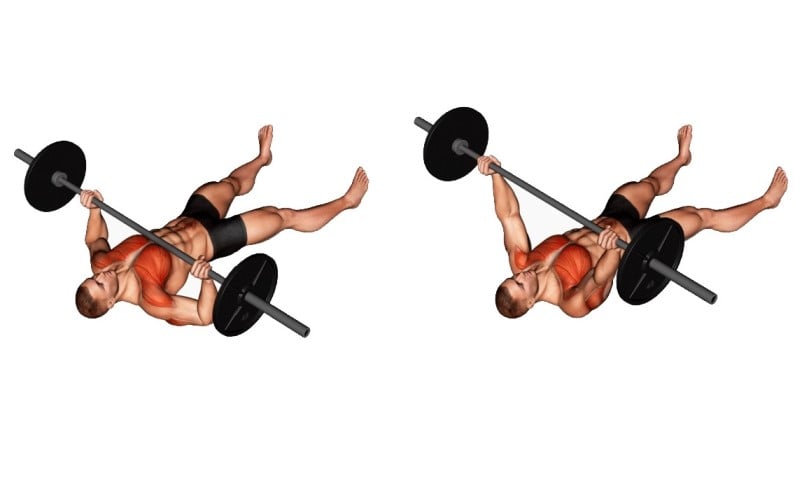
11. Barbell Guillotine Press
The barbell guillotine press is an advanced chest exercise that intensely targets the upper pectoral muscles.
It’s named for how the barbell is lowered towards the neck rather than the chest.
This variant allows for a slightly greater range of motion compared to the standard bench press
Note: It is recommended to perform this exercise with a spotter for safety reasons, as the bar path leads toward the neck.
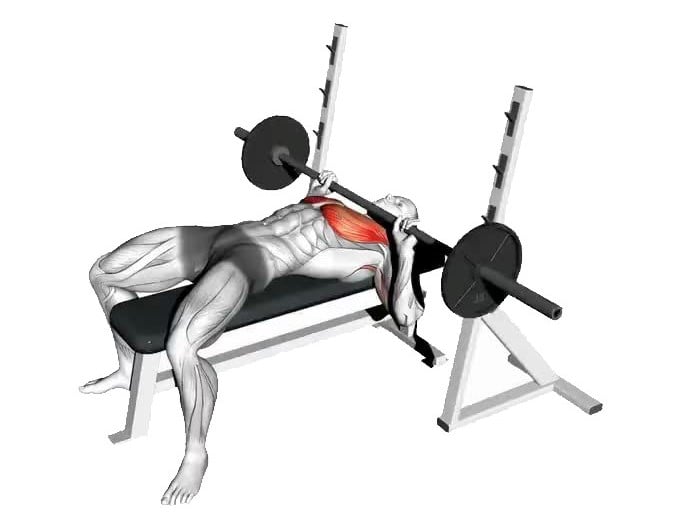
12. Bench Pin Press
The bench pin press is performed on a power rack. Set the pins or safety bars at a height a few inches off your chest while lying on a bench under the barbell.
You then perform lockout repetitions by pressing the bar from the pins.
This forces the lifter to press the bar from a complete stop, which eliminates any rebound effect and requires more force.
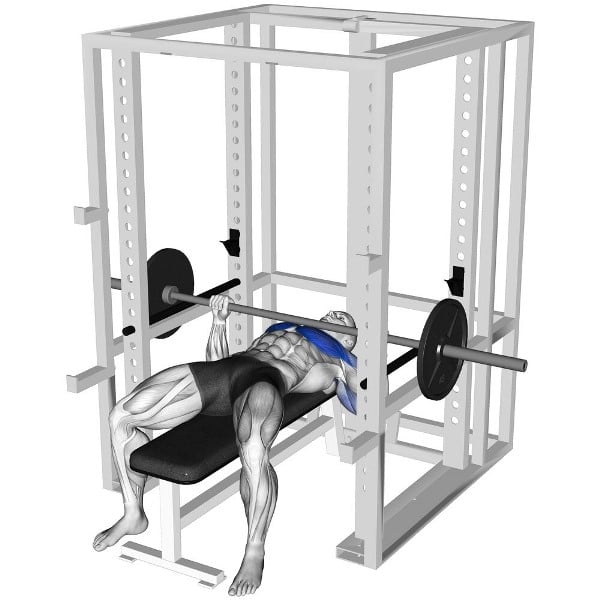
13. Barbell Board Press
The barbell board press, also known as the block press or pause press, is a powerful variation of the classic bench press.
The exercise is essentially a standard bench press with a twist: a board is placed on your chest, restricting the range of motion.
- You grip a barbell and press it downwards until it touches the board.
- Hold for a moment, then press it back up to the starting position.
It offers unique benefits for building strength, improving technique, and overcoming sticking points.

14. Spoto Press
The Spoto Press is a bench press variation developed by Eric Spoto, an elite presser. This means stopping the bar about an inch above your chest and then pushing the weight up hard.
It is similar to a bench press, but with a crucial difference: you pause for 1–2 seconds about an inch (2.5cm) off your chest before pressing the bar back up.
- It is useful for powerlifters looking to improve their bench press, particularly the pause required in competition.
- It can be useful for overcoming chest-oriented bench press plateaus.

15. Landmine Floor One Arm Chest Fly
The landmine floor one arm chest fly is a unilateral exercise that targets the chest, shoulders, and triceps muscles.
You can also perform this exercise with both arms by using a double-sided landmine attachment or performing the exercise one arm at a time.
You can also perform the exercise on a bench instead of on the floor.
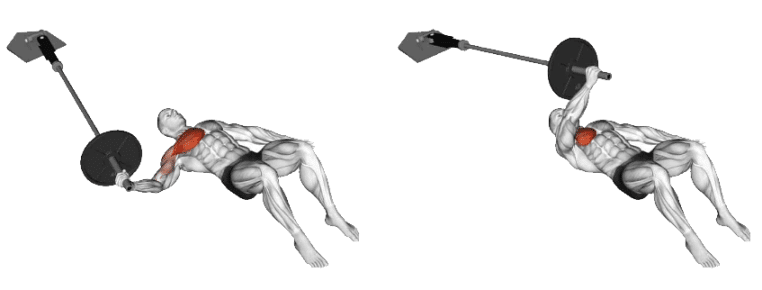
Barbell Back Exercises Names
The back is a crucial muscle group for strength, posture, and physique. To develop a thick, powerful back, barbell rows should be a staple in your training routine.
The barbell lets you lift heavy and build serious strength and muscle mass in your back.
This list of must-know barbell back exercises will have you well on your way to a defined, V-tapered torso.
1. Deadlift
The Deadlift is a powerhouse move that’s not just about strength, it’s a symphony of muscle coordination, power and technique.
Deadlifts are the ultimate full-body workout. They primarily target your posterior chain (the backside of your body) – glutes, hamstrings, and lower back. But that’s not all; your core, arms, and shoulders get a piece of the action too.
The high rate of muscle recruitment makes deadlifts excellent for boosting testosterone and metabolism, that aid in weight loss and muscle growth.
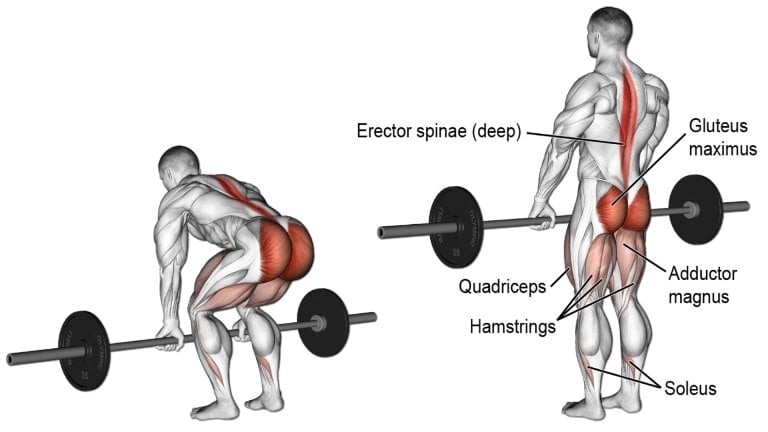
2. Bent Over Barbell Rows
The bent-over barbell row is one of the most effective back exercises you can do with a barbell. This compound movement targets several major muscle groups in your back to build thickness and strength.
This exercise targets a wide range of muscles in your back, including the latissimus dorsi, rhomboids. It also engages your rear deltoids, trapezius, rhomboids, and spinal erectors.
You can vary your grip width and style (like using an underhand grip) to target different aspects of your back muscles.
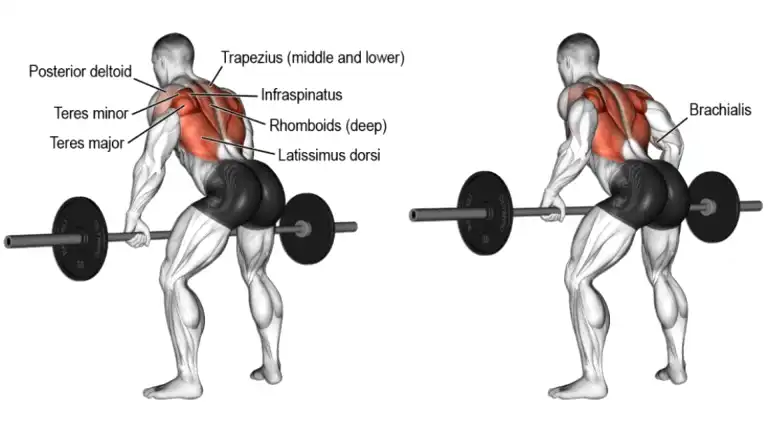
3. Landmine Row
The landmine row is a unique strength training exercise that builds serious back muscle and power. It involves holding one end of a barbell loaded with plates and rowing the weight toward your body with a neutral grip.
It will do an absolutely stellar job of targeting your lats, traps, posterior delts, and rhomboids. This is one of the best exercises you can do for pure back thickness.
Unlike traditional barbell rows, landmine rows reduce stress on your shoulders due to the natural movement path.
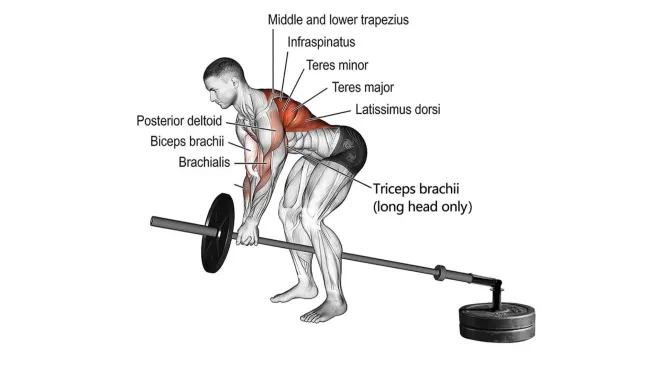
4. Standing Barbell Rear Delt Row
Unlike bent-over barbell rows, the standing barbell row provides more rear delt emphasis by allowing you to pull the barbell back towards your upper chest rather than your lower ribs.
It is an effective back exercise targeting your rear deltoid muscles. Also, hitting the lats, traps, rhomboids, and biceps, this move builds impressive “3D” back thickness while improving posture.

Want to take your gains to the next level? Discover your daily calorie needs with our free TDEE calculator.
5. Barbell Upright Row
The barbell upright row is a powerful shoulder and upper back exercise that builds strong, defined deltoids and traps.
The exercise is named “barbell upright row” because the barbell is lifted up in a vertical, or upright, direction.
It can be performed with three main variations of grip width:
- The close or narrow grip (half of shoulder width),
- A standard grip (shoulder-width grip)
- A wide grip (wider than the shoulder)

6. Barbell Chest Supported Row
The chest-supported row exercise is an effective variation of the bent-over barbell row.
As the name suggests, it’s a row where your chest is supported. It is a highly effective exercise with the added benefit of minimizing lower back strain.
This row is much more effective for targeting the back muscles because it doesn’t require other muscles to stay stable throughout the movement.

7. Barbell Shrug
The Barbell shrug is one of the best exercises to build bigger, stronger trapezius muscles.
It is one of the best isolation exercises for the trapezius muscle. The shrug is one of the simplest and easiest exercises to perform. You need to add this barbell back exercise to strengthen your upper back and trap muscles.

8. Barbell Good Morning
The barbell Good Morning is a posterior chain exercise that builds tremendous lower back and hamstring strength.
- The erector spinae muscles of the lower back work isometrically to keep the spine in an extended position,
- Meanwhile, the hamstrings, and gluteus maximus work isotonically to perform hip extension.
Good mornings are more advanced than back extensions and are an excellent move for sports athletes.
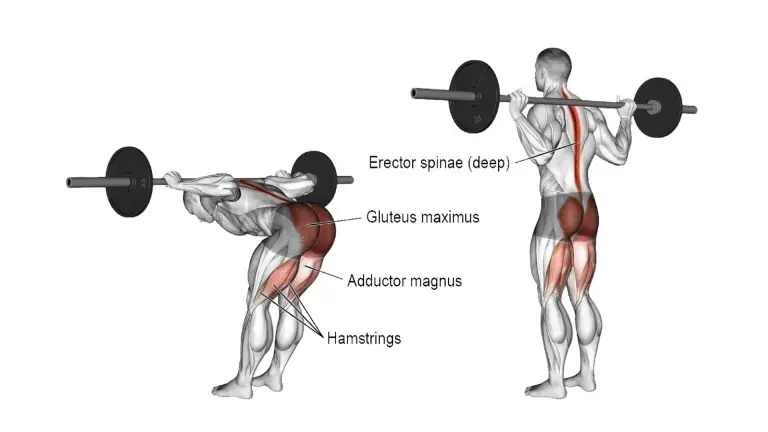
9. Landmine Deadlift
The landmine deadlift is a great exercise for building strength in your posterior chain and improving your grip strength.
And this new way of doing the traditional deadlift makes your workout more interesting. It is the biggest muscle builder, recruiting more muscle motor units than any other exercise.
You can go really heavy on a Landmine deadlift, but do this exercise with caution and technique.
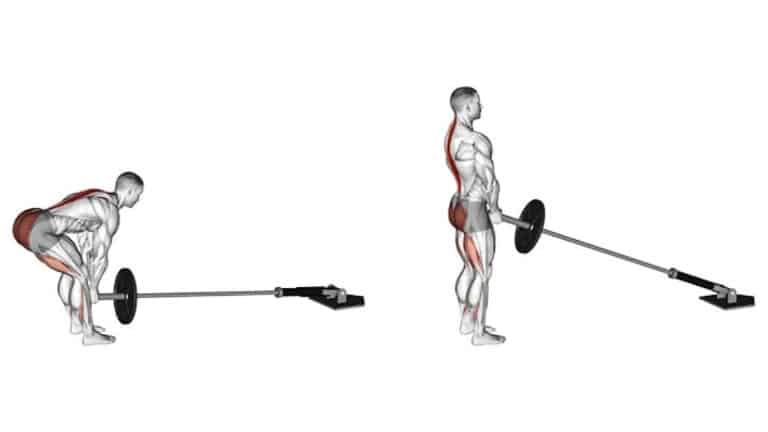
10. Seal Row (Flat Bench Row)
The prone row is performed on a special elevated bench, on a bench placed on top of boxes or benches. The higher the bench, the greater the range of motion and stretch at the bottom of the movement.
The flat bench-supported row is a great alternative to a supported row for two main reasons.
- Because the bench supports you, there is significantly less tension placed on the lower back.
- You can’t cheat with your momentum. This will ensure we get more recruitment from the muscles we are trying to work in the mid-back and lats.
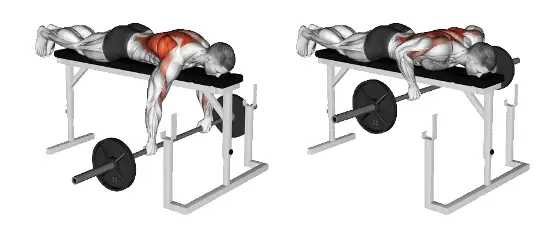
11. Meadows Row
When doing a lat workout with a barbell, you can add plenty of single-arm exercises to correct potential imbalances.
The meadow row is a unilateral landmine exercise used to target the back muscles. This exercise targets your latissimus dorsi, trapezius, and rear deltoid muscles.
If done properly, it will create small muscle tears, which will heal and cause your muscles to grow stronger and larger.
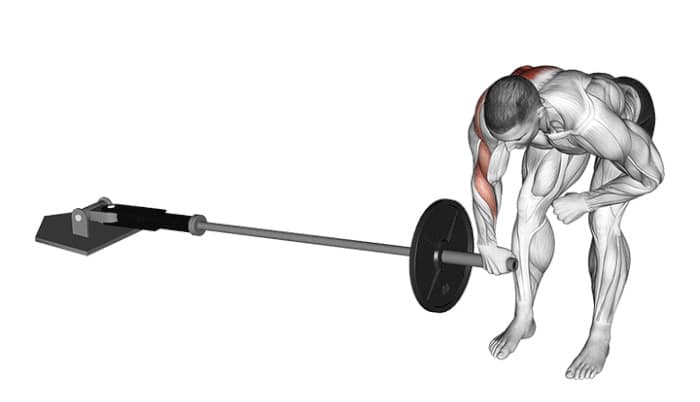
12. Barbell Hip Bridge
When you spend most of your day sitting, your glute muscles can weaken, while the hip flexors in the front of your thighs can shorten, making them feel tight.
But when you practice glute bridges regularly, you target your glutes, hamstring, and lower back muscles; those muscles meant to hold your body upright will get stronger.
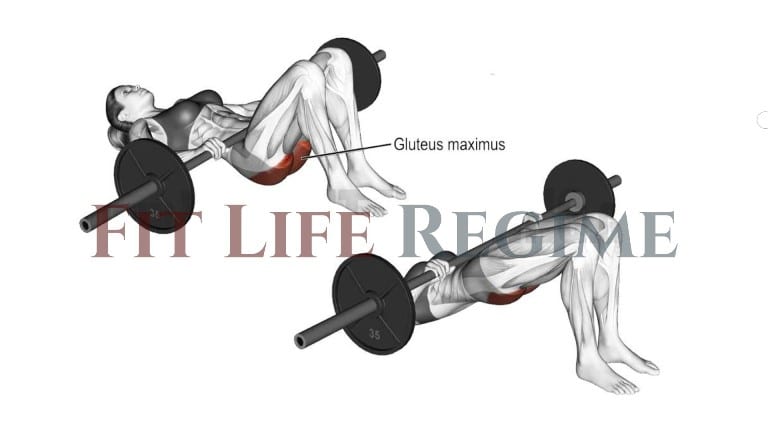
13. Clean And Jerk
The hang clean and jerk is a complex exercise that involves multiple movements performed in quick succession.
It requires to be coordinated flexion and extension of various joints and muscles throughout the body, combining pulling and pushing motions into a single exercise.
It is an effective and efficient way to achieve a full-body workout in a short period of time.
Not only that, but it is one of the lifts that athletes do at events like the Olympics and other weightlifting competitions.
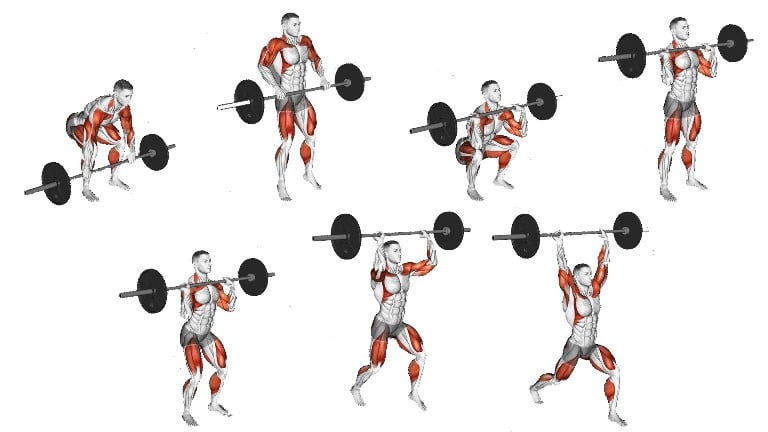
14. Pendlay Row
The Pendlay row strengthens your muscles and adds muscle mass to your lats, traps, and rear delt. It was named after legendary powerlifting coach Glenn Pendlay.
Unlike a traditional barbell row, the Pendlay row begins with the barbell resting on the floor on each rep. This allows you to maintain tension in the lats, lift heavier weights, and achieve a greater range of motion. It’s like a mix between a barbell row and a deadlift.
While it may appear simple at first glance, mastering the Pendlay Row unlocks a potent weapon for building a thick, powerful back.
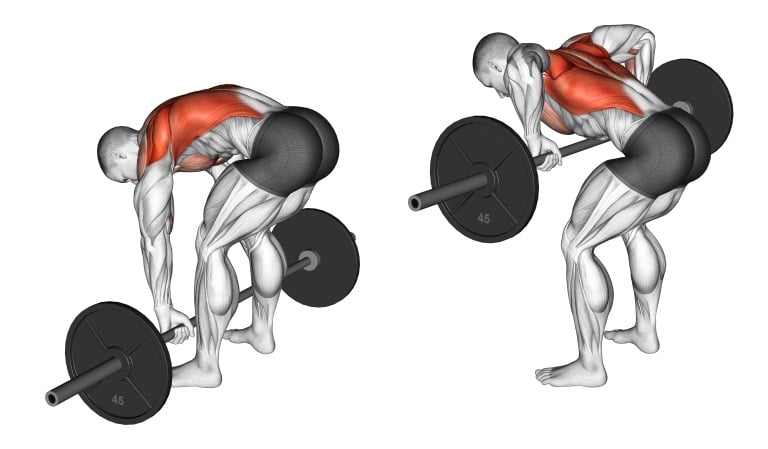
15. Rack Pull
The rack pull is an exercise that can boost your pulling power and build up your back. It targets the posterior chain, including the glutes, hamstrings, lower back and upper back.
This exercise is beneficial for developing muscle hypertrophy, fundamental pulling strength, and grip strength.

16. Barbell High Pull
The Barbell High Pull is an explosive and multijoint workout focusing on the upper body, including the arms, upper back, and traps. It’s a good way to make yourself more athletically strong.
- Stand with your feet shoulder-width apart and hold a barbell.
- From this position, explosively extend hips, knees, and ankles, pulling the barbell towards your chin.
- Raise the bar to chest or shoulder height, no higher.
- Carefully lower the bar back to the starting stance.
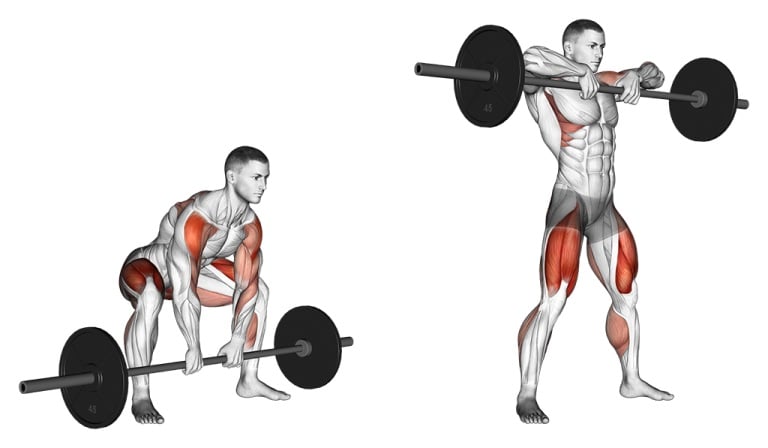
17. Snatch Grip Deadlift
The snatch grip deadlift is an advanced variation of the traditional deadlift, with a wider grip on the barbell.
The wider grip of the snatch grip deadlift works more of the upper back than the lower back.
It’s best to learn how to do a traditional deadlift before you try a snatch grip deadlift.

Barbell Shoulder Exercises Names
Having well-developed shoulders is essential for a proportional and athletic physique. Barbells allow for heavy overhead lifts to build 3D deltoids.
This section will introduce more than 10 renowned barbell shoulder exercises, with detailed descriptions and illustrative images.
The exercises will cover variations like barbell overhead shoulder press, barbell front raises, barbell upright rows, and more.
1. Military Press
If you’re looking for straightforward barbell shoulder exercises to add to your home routine, Overhead Press are a great staple exercise to get you started.
The military press is used primarily to build the deltoid muscle. It also indirectly targets the other muscles of the shoulder, your triceps, and your core.
Since the military press is completed standing up, it involves a lot of core strength to help stabilize the spine while pressing weight overhead.
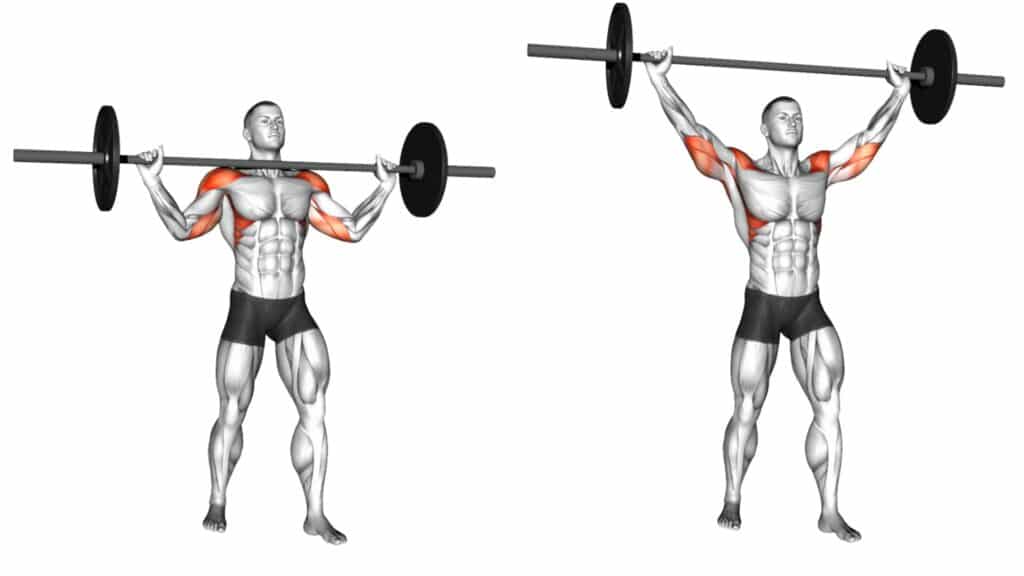
2. Seated Barbell Overhead Press
You can do this shoulder exercise at home or in the gym during your upper body workouts. The shoulder press remains the most effective exercise for building big, round shoulder muscles.
This exercise is similar to the standing overhead press, but it’s done while sitting on a bench. This makes it safer to lift heavier weights and helps you make progress more often.

3. Barbell Front Raise
The barbell front raise is a shoulder exercise used to target the front deltoids.
It involves lifting a barbell in front of the body while keeping the arms straight, making it an effective way to isolate and strengthen the shoulders.
It is possible to overload the muscles with the barbell to a greater degree than one may be capable of doing with dumbbells.
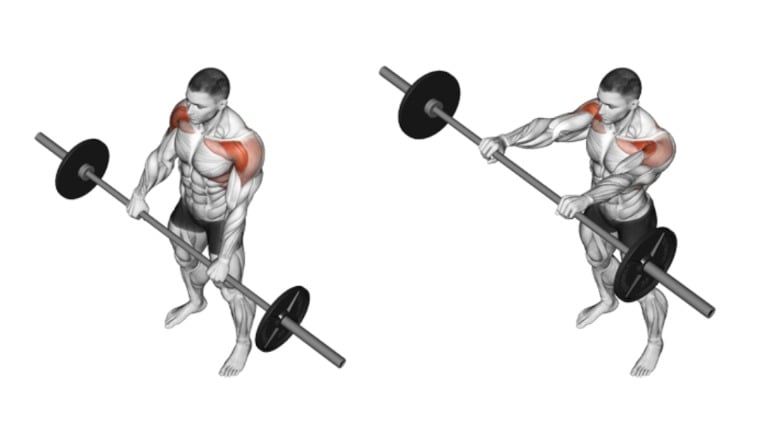
4. Behind-The-Neck Press
A behind-the-neck press is an exercise that targets your shoulders. The standard military press and the overhead dumbbell press hit more of the anterior head of the deltoid, which is often stimulated a lot, even during the bench press.
On the other hand, it stimulates all three heads of the shoulder. It also recruits the triceps, traps, and rhomboids.
If you do not have a fair amount of shoulder mobility, performing these barbell shoulder exercises is not recommended.
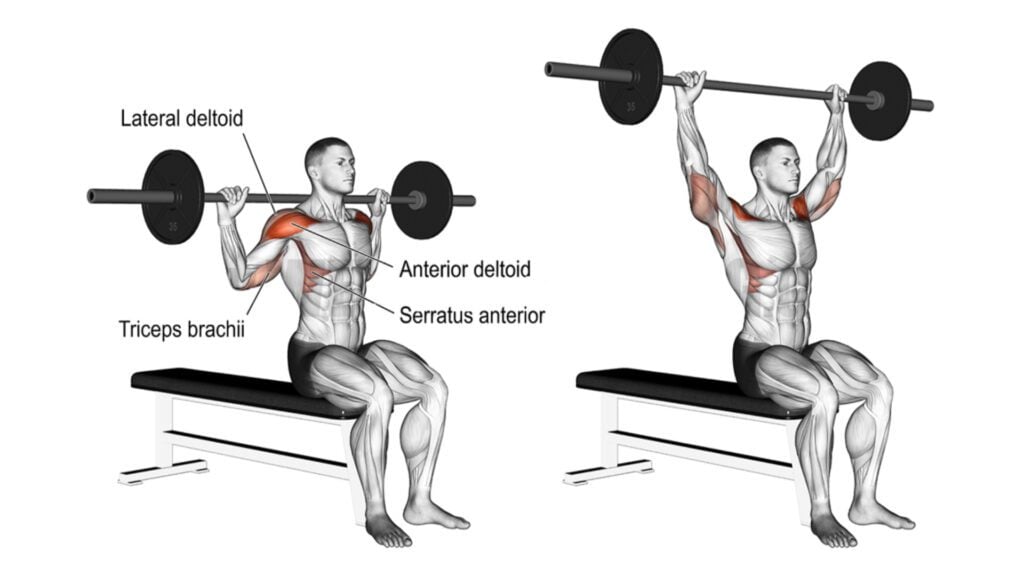
5. Barbell Lying Rear Delt Row
The barbell lying rear delt row is an exercise primarily targeting the rear deltoids, upper back, and rhomboids.
When done correctly, it can effectively target your shoulders and upper body.
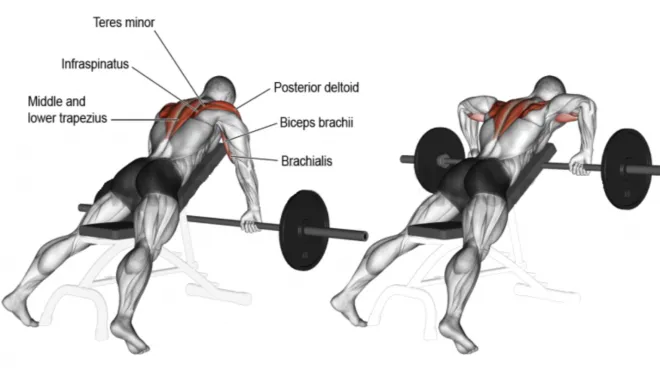
6. Standing Barbell Rear Delt Row
Unlike bent-over barbell rows, the standing barbell row provides more rear delt emphasis by allowing you to pull the barbell back towards your upper chest rather than your lower ribs.
It is an effective back exercise targeting your rear deltoid muscles. Also, hitting the lats, traps, rhomboids, and biceps, this move builds impressive “3D” back thickness while improving posture.

7. Bradford Press
The Bradford Press involves alternating barbell presses to the front and back of the head without fully locking out the arms.
It targets multiple parts of the deltoids – anterior (front), medial (side), and posterior (rear) deltoids.
- The exercise starts with a shoulder-high barbell in front of the neck.
- Press the barbell, then move it just over and behind the head.
- You then reverse the movement to bring the barbell back to the front.

8. Standing Wide Grip Shoulder Press
This exercise is done standing and using a barbell with a wider grip than your shoulder width.
Some Benefits:
- The wider grip can increase the recruitment of the lateral (side) deltoids.
- It may also involve the upper chest and trapezius muscles to a greater extent.
- Some people find that a wider grip can reduce discomfort in the shoulder joint.

9. Close Grip Military Press
The close-grip military press is a great way to work your triceps and shoulders more than the usual overhead press.
This exercise uses a narrower hand placement than the traditional shoulder-width grip.
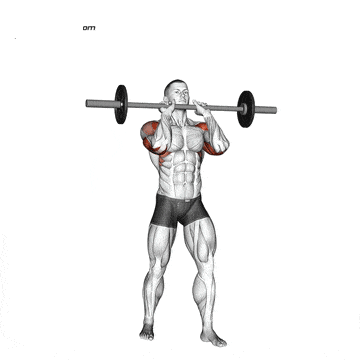
10. Single Arm Landmine Shoulder Press
This exercise is not very well-known, but it has unique benefits and can be a good addition to your shoulder workout routine.
The landmine setup creates a unique arc, which is more shoulder-friendly than straight overhead presses. This can reduce the risk of shoulder impingement.
Doing one arm at a time helps you spot and fix any imbalances in strength between your shoulders.

11. Barbell Z Press
The Barbell Z Press is a challenging and effective shoulder exercise that strongman Zydrunas Savickas popularized, hence the name “Z Press.
A barbell is used to perform the Z Press while sitting on the floor with legs extended forward.
This seated position eliminates leg drive and lower-body assistance, making it a pure upper-body workout.

12. Barbell Split Jerk
The Barbell Split Jerk is a powerful and dynamic exercise that is primarily performed in Olympic weightlifting.
It is also popular among athletes and strength trainers for its ability to develop explosive power, coordination, and strength. It develops explosive strength in the legs, hips, and shoulders.
Furthermore, it is a compound exercise that involves lifting a barbell overhead and splitting the legs into a lunge position.

13. Incline Barbell Front Raise
It is a variation of the traditional front raise exercise, focusing on the anterior (front) deltoid muscles.
This exercise is done with an incline bench to change the angle of resistance and uniquely challenge the shoulder muscles.
- Set an incline bench to about 30–45 degrees. Lie face down on the bench.
- Lift the barbell up in front of you to shoulder height.
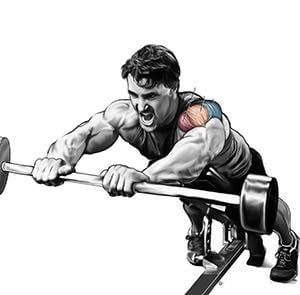
14. Wide Grip Barbell Upright Row
The wide-grip barbell upright row is preferable to the regular upright row because it prevents the elbows from going too high, preventing rotator cuff injuries.
The wide-grip upright row places heavy emphasis on the lateral and rear deltoid and little less on the upper and middle trap
Furthermore, the wider grip allows some cheating movement, thereby allowing you to lift more weight.
It may also be more shoulder-friendly for people who cannot handle the close-grip version.

Barbell Bicep Exercises Names
The barbell lets you work out and push yourself to the limit to build up some serious biceps.
This section will list over 15 popular barbell bicep exercises with descriptions and pictures.
Moves will include barbell curls (wide, narrow, standard grip), reverse barbell curls, incline curls, 21s, and more.
1. Barbell Bicep Curl
The barbell bicep curl is a well-known workout for building arms, and it’s been around for a long time.
It is an isolation exercise that works primarily on your biceps and also trains the muscles in your forearms.
Unlike dumbbell curls, where each arm works independently, the barbell forces both biceps to work together with equal weight. This allows for progressive overload.
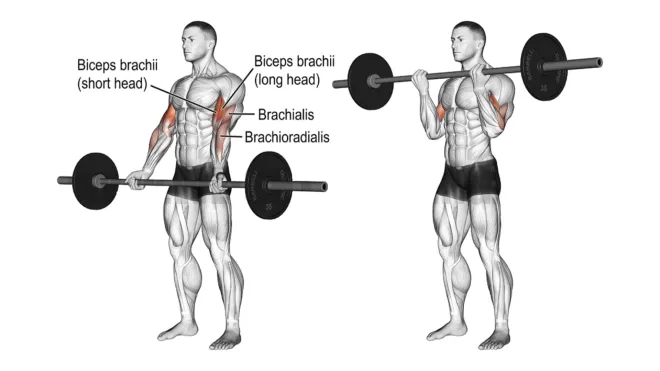
Want to take your gains to the next level? Discover your daily calorie needs with our free TDEE calculator
2. Barbell Preacher Curl
The Preacher curl is another great exercise for your barbell bicep workout. This exercise is a favorite for those looking to add serious size and definition to their arms.
The preacher bench is great for keeping the biceps isolated by limiting the involvement of other muscles.
The angle of the preacher bench puts your arms in front of your body, which intensifies the work on the biceps throughout their entire range of motion.
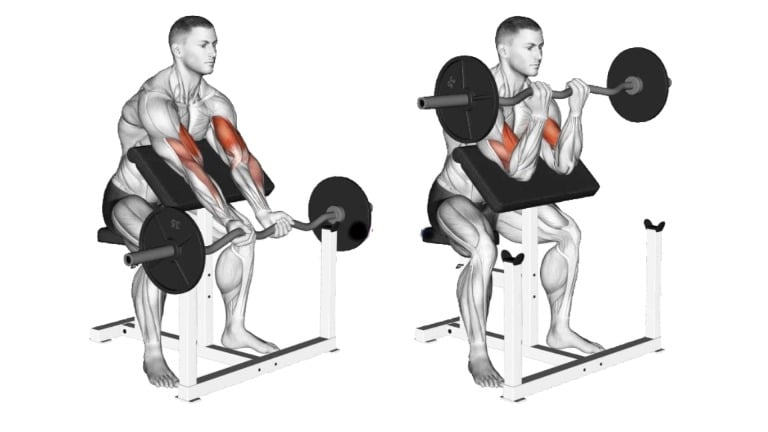
3. Barbell Spider Curl
If you’re looking for a way to get more creative with your barbell biceps workout, why not try the barbell Spider Curl?
It trains your biceps in a shortened (which is to say, a maximally contracted) muscle position. This results in a powerful muscle pump, which makes your arms appear more vascular, which can also lead to significant hypertrophy.
It is typically done with a barbell. However, you can also use an EZ bar or dumbbell.
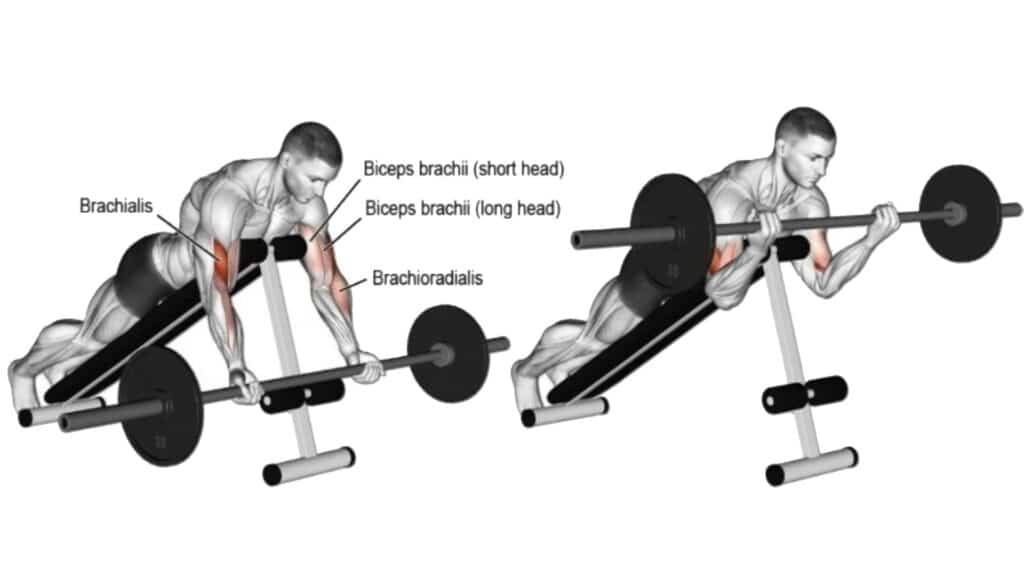
4. Barbell Drag Curl
This barbell exercise is another great option that will help you target the biceps and grow your arms.
While less popular than the standard barbell bicep curl exercises, the barbell drag curl is an extremely effective bicep exercise.
It is performed by holding a barbell close to the body, dragging and curling it towards the shoulder in a smooth, controlled motion.
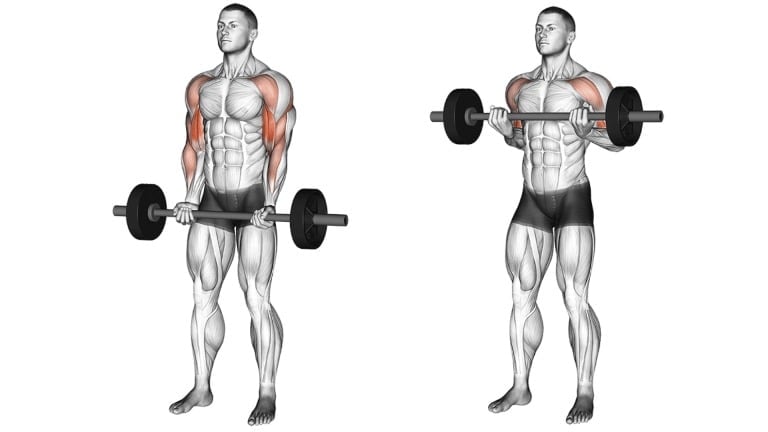
5. EZ Bar Curl
The EZ bar is a curved barbell with a more ergonomic grip than a straight barbell. This makes it a more comfortable exercise to perform, especially for people with wrist pain.
Due to the semi-pronated grip, the brachioradialis has slightly increased engagement in the forearm.
In the study, they found that doing the EZ barbell curl worked more of the biceps brachii (BB) and brachioradialis (BR) muscles than doing the dumbbell curl (DC) or barbell curl (BC)
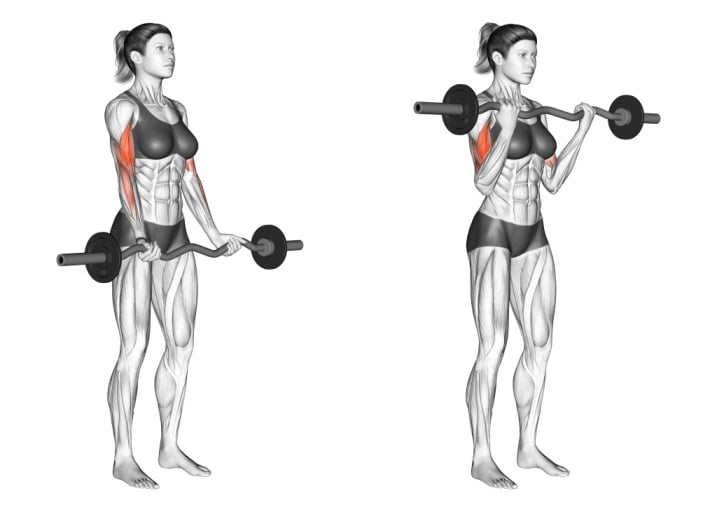
6. Barbell Reverse Curl
The barbell reverse curl is a non-negotiable component of arms training.
Unlike the traditional bicep curl, it is performed with an overhand grip (palms facing down) on the barbell.
This subtle change in grip shifts the focus more towards the brachioradialis, a muscle of the forearm, and the outer portion of the biceps.
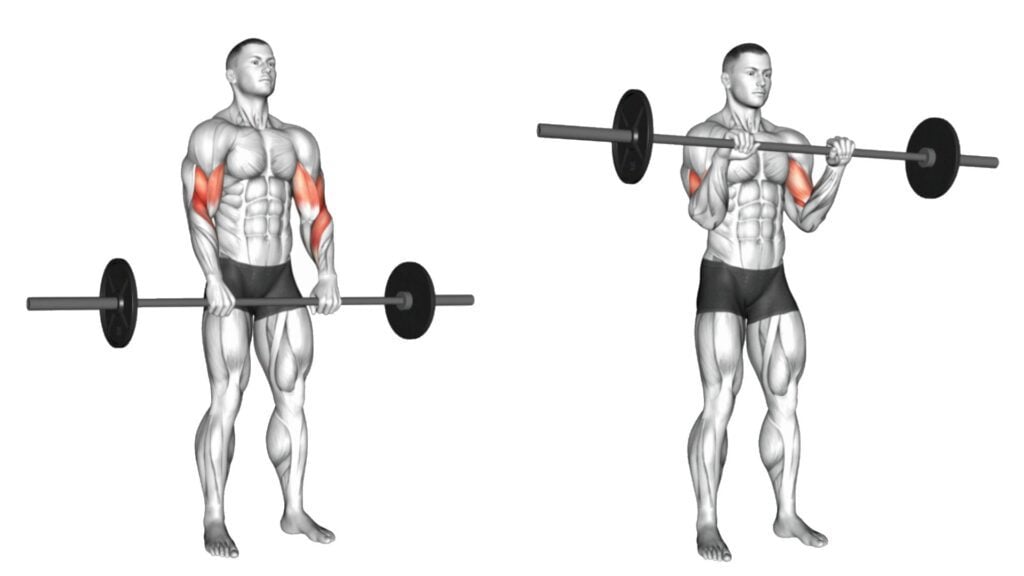
7. Barbell Hammer Curl
Using a barbell allows you to lift heavier weights than dumbbells, leading to greater strength and muscle development in the biceps, brachialis, and forearms.
Holding a barbell with an overhand grip challenges your grip strength, promoting improved forearm and hand grip capabilities.
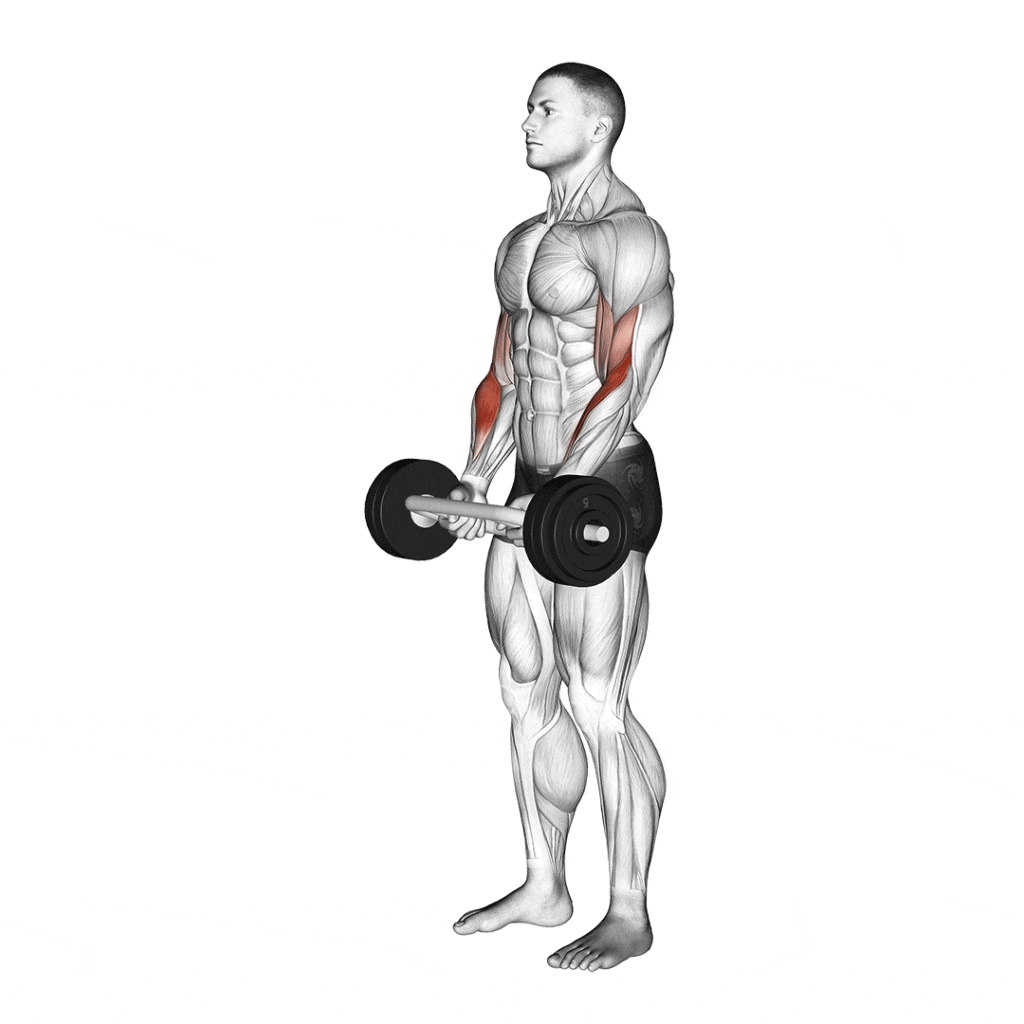
8. EZ Bar Seated Concentration Curl
The EZ bar seated concentration curl is an exercise that primarily targets the biceps and forearms.
It is a variation of the concentration curl, which is an isolation exercise that mainly targets the biceps brachii muscle.
Its unique benefits include its ability to isolate and concentration, which increases the effectiveness of the movement.
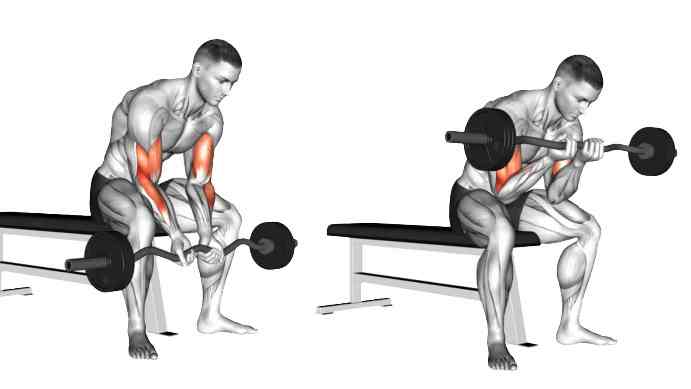
9. EZ Bar Reverse Grip Preacher Curl
If you’re looking for a way to get more creative with your reverse biceps curls, why not try the EZ bar reverse preacher curl? It is great for building both the forearm and the upper arm.
During this exercise, the long head of the biceps brachii is activated more than the short head. The long head is stretched out more in this position, which means it can contribute more to the curl.
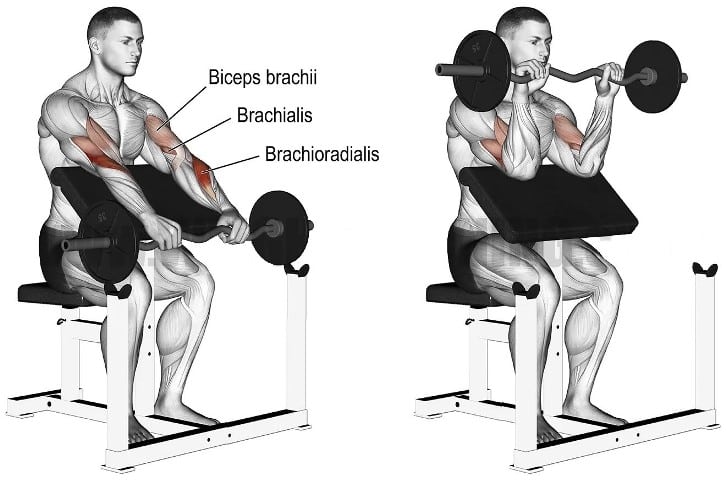
10. Close Grip Barbell Curl
The close grip barbell curl is a powerful tool for sculpting impressive bicep peaks and building impressive bicep strength.
The shorter distance between your hands places intense focus on the outer head of your biceps brachii.
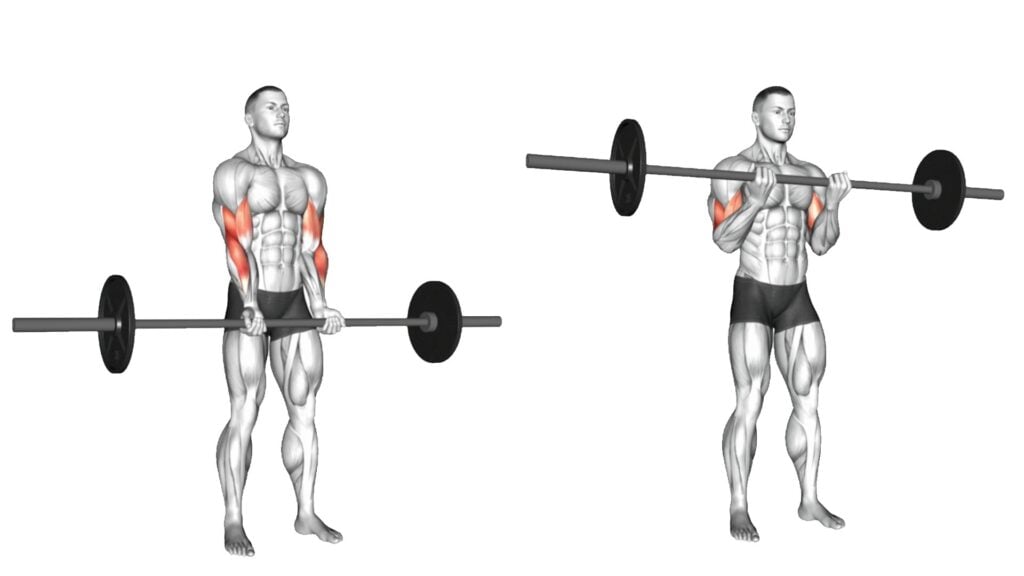
11. Wide Grip Ez Bar Curl
If you want to target your inner biceps, the wide grip bar curl is a great exercise. You may find it easier to focus on the short head as your hands are wider apart during the movement.
The straight bar version of this exercise is excellent, too. However, it can cause wrist and forearm discomfort for many lifters due to the need for a fully supinated grip.
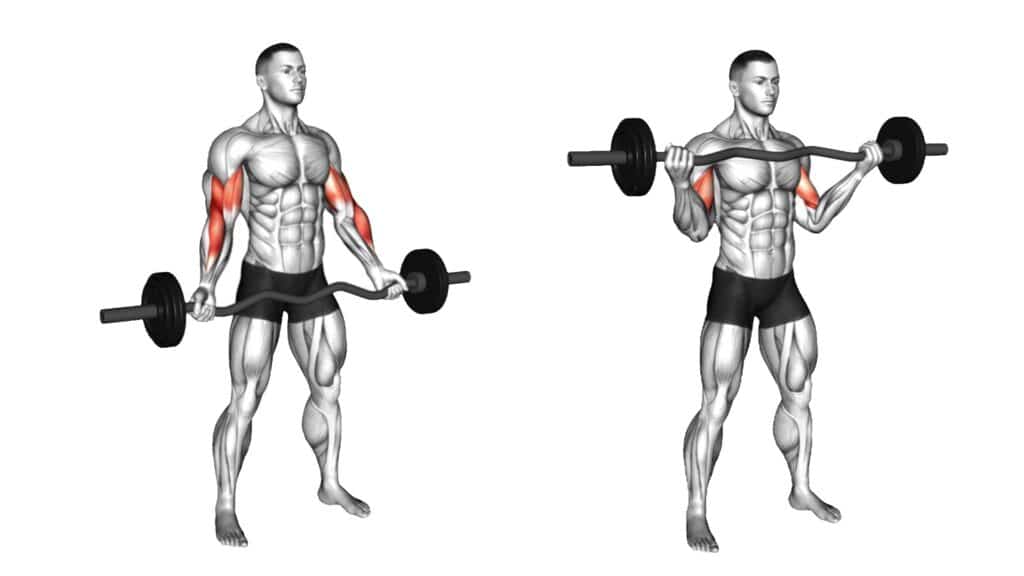
12. Standing Barbell Preacher Curl
As the name suggests, the standing preacher curl is a version of the basic seated preacher curl.
You may also stand on the reverse side of the bench to execute the movement.
The body should be positioned to allow the armpit to rest near the top of the pad. The back of the upper arm should remain on the pad throughout the movement.

To Stay Motivated: 150+ Gym Workout Motivational Quotes To Stay Fit
13. 21s Barbell Bicep Curl
The 21s barbell bicep curl gets its name because it consists of 3 sets of 7 repetitions, totaling 21 reps. This exercise consists of three parts: the bottom portion, middle portion, and top portion.
- 7 Lower-Range Curls: Start with the barbell at your thighs and curl it up only halfway. Perform 7 reps of this partial movement.
- 7 Upper-Range Curls: Begin with your forearms parallel to the ground and curl the barbell up to your shoulders, then back down to the halfway point. Again, do 7 reps.
- 7 Full-Range Curls: perform 7 full-range curls starting from your thighs and curling all the way up to your shoulders, then back down.
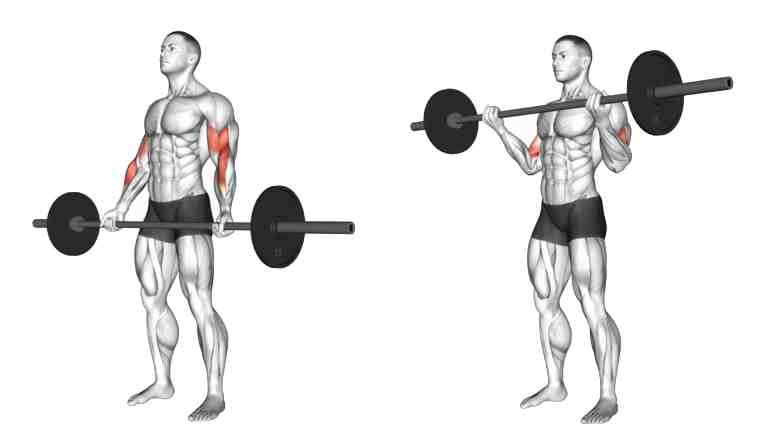
14. Barbell Curl On An Arm Blaster
It is a great way to strengthen the biceps brachii muscles. An arm blaster is a piece of exercise equipment that is a harness-like device with a metal plate.
This piece is worn around the neck and rests on the upper part of your stomach. It helps keep the arms together with the body.

Barbell Tricep Exercises Names
The barbell allows for intense triceps training under heavy loads, which promotes muscle growth.
This section will introduce over 15 of the most effective barbell triceps exercises, with detailed descriptions and illustrative images.
The comprehensive list covers tried-and-true basics like skull crushers, close-grip benches, and French presses.
1. Lying Barbell Triceps Extension
The Lying Barbell Triceps Extension, often known as “Skull Crushers,” is a weight training exercise that focuses on the triceps muscles.
It is one of the best for building a bigger tricep, as it equally targets all three triceps’ heads.

2. Overhead Barbell Triceps Extension
The overhead barbell triceps extension is an exercise that primarily targets the triceps. It can be performed in a standing or seated position
It works all three heads of the muscle, and it especially targets the long head of the triceps.
You can perform the it with a regular barbell or an EZ bar. The EZ bar can be easier on your wrists and might give you a more secure grip
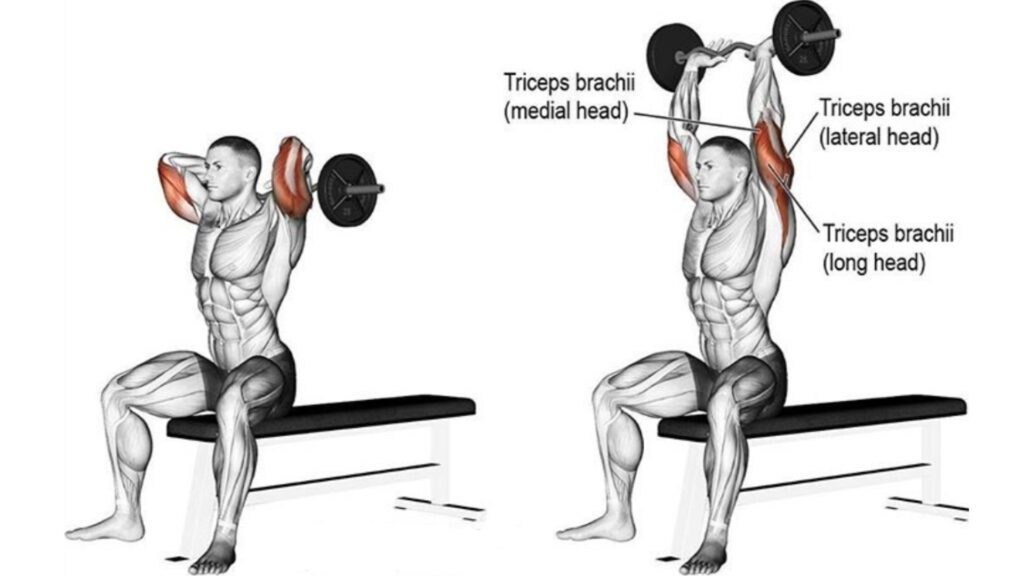
3. Close-Grip Bench Press
The close grip bench press is superior when discussing barbell exercises for the triceps that will pack mass onto your triceps.
It is an often overlooked but incredibly effective exercise targeting chest and tricep muscles.
Unlike the traditional bench press, which primarily targets the chest muscles, the close grip version focuses more on the triceps and the inner chest.
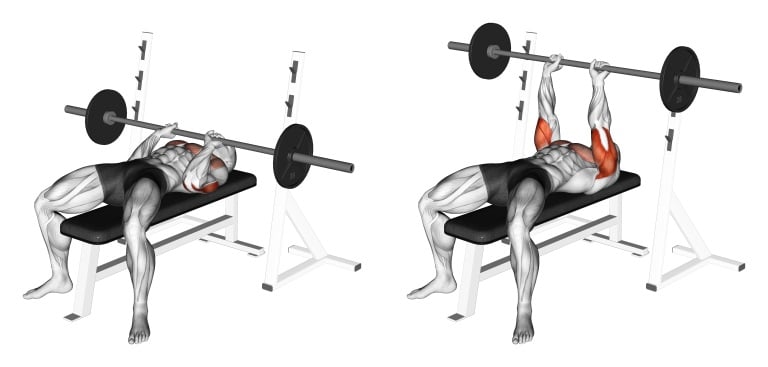
4. Incline Barbell Tricep Extension
As the name suggests, the incline barbell tricep extension is an exercise performed while lying on an incline bench with a barbell held overhead.
The incline angle puts more emphasis on the long head of the triceps.
This position is better for people with shoulder problems because it puts less pressure on the shoulder joints than flat or decline positions.

5. Decline Barbell Tricep Extension
Unlike the incline version, where you lie on an incline bench, the decline barbell tricep extension involves lying on a decline bench with a barbell held overhead.
The decline angle creates a deeper stretch in the triceps at the bottom of the movement.
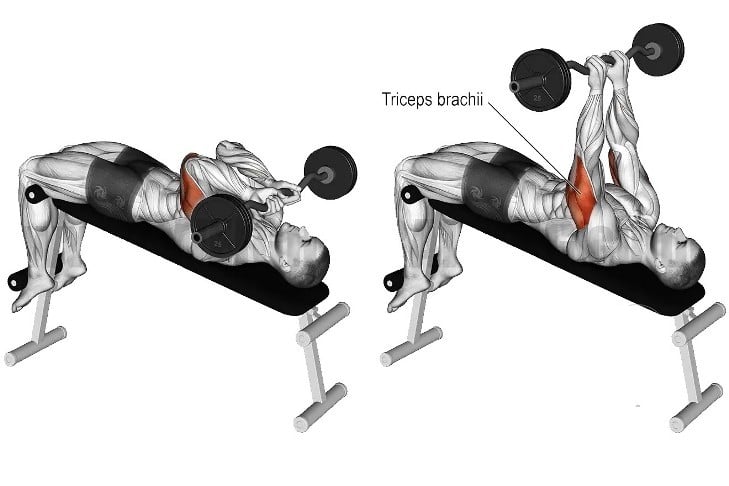
6. Reverse Grip Skull Crusher
Reverse skull crushers are a remarkable tricep exercise because they encourage you to keep your elbows tucked in rather than flared out.
This technique certainly strengthens the triceps, but performing reverse grip skull crushers is actually quite risky unless you use lifting straps or Versa Grips to secure the bar.

7. Reverse Grip Barbell Press
The reversible grip barbell press, a simple and highly effective shoulder-friendly pressing variation, helps build strength in your triceps.
It is often done to improve locking strength and focus on developing triceps.
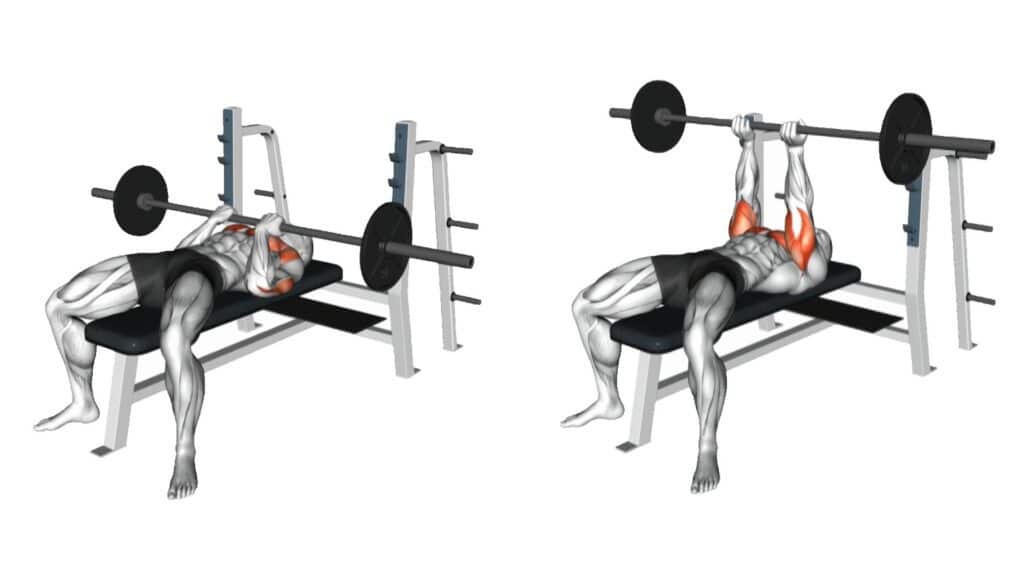
8. Barbell JM Press
The JM press, named after Jim Morris, a powerlifter, is a totally different tricep workout. This special version of the barbell press helps strengthen and shape your triceps.
It is a hybrid movement combining elements of a close-grip bench press and a skull crusher (tricep extension).

9. Incline Close Grip Bench Press
The incline close grip bench press combines the benefits of close grip bench presses for working the tricep muscles with the benefits of incline bench exercises for working the upper chest muscles.
You can also use the EZ bar, which is more comfortable for some people because it has an angled grip.
I like using an EZ bar to do close-grip bench exercises. It helps me get good muscle gain without hurting my wrist.

Barbell Leg Exercises Names
Barbells are a great tool for building leg strength. They allow you to lift heavy and overload your leg muscles.
This section will introduce over 15 popular barbell leg exercises with detailed descriptions and illustrative images.
The exercises will cover variations like barbell squats, lunges, deadlifts, and more. You’ll learn the proper technique for each exercise to maximize leg development safely.
Keep reading to discover the best barbell moves to build defined, muscular legs!
1. Barbell Squat
If there is only one exercise you want to do for leg exercises, then it should be squats. Nothing comes close to squat exercises to build muscle mass and tone the leg muscles.
The barbell squat is the king of all exercises, the only challenger being the barbell deadlift.
Men love this exercise because it is great for strengthening the legs and core, making the body release testosterone, and helping to build body-wide muscle and strength.
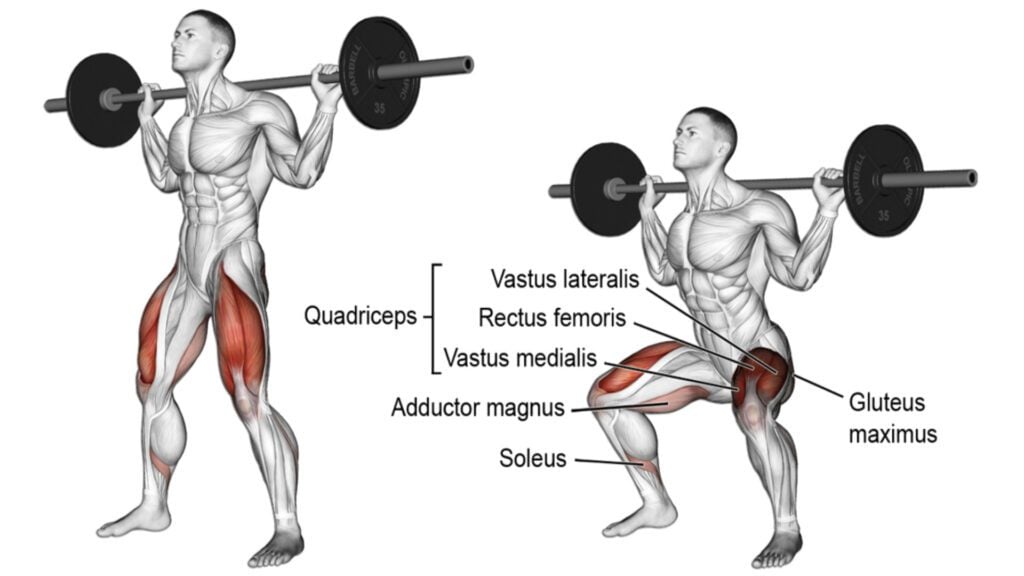
2. Barbell Lunges
The barbell lunge is a brilliant exercise to develop balance, coordination, and the unilateral (one-sided) functional strength of your legs, which is important for athletic performance and overall fitness.
Barbell Lunges are a power move to build thigh and butt muscles.

3. Barbell Front Squat
The front squat is a more advanced version of the barbell squat that works the muscles of the legs. The front squat will place a great deal of emphasis on the quads.
The barbell squat and the barbell front squat work the same target and synergistic muscles.
However, the barbell front squat recruits more stabilizer muscles, including various back muscles, your shoulders, and chest.
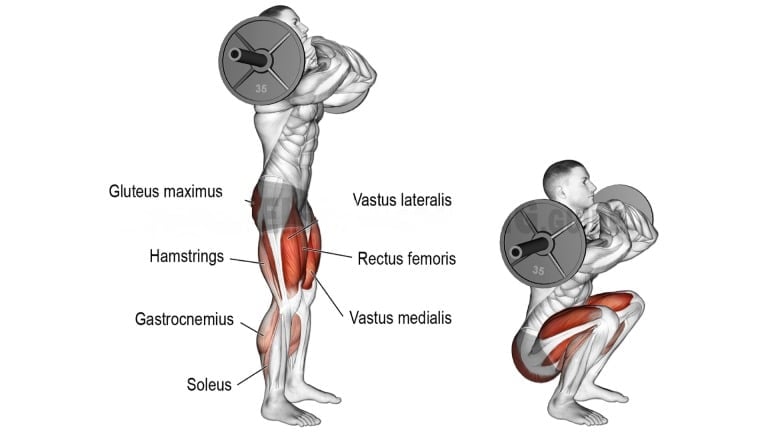
4. Stiff-Leg Deadlift
The stiff leg deadlift is a variation of the deadlift and an exercise used primarily to target the muscles of the hamstrings gluteals and erector spinae.
The stiff-leg deadlift for hamstrings requires a lighter weight than the traditional deadlift lift to strengthen the lower back.
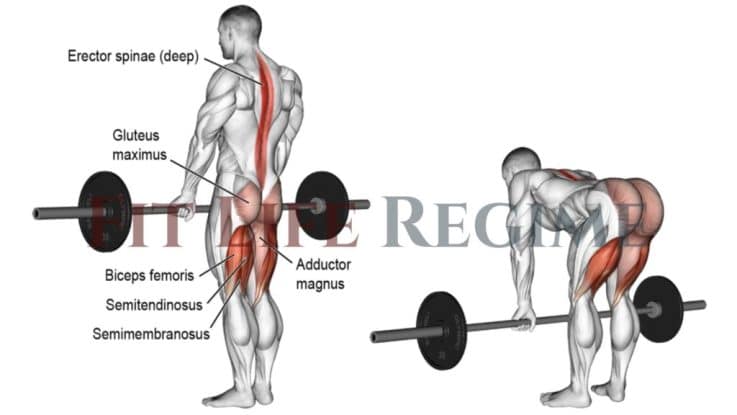
5. Landmine Deadlift
The Landmine deadlift is a variation of the deadlift that lets you use the deadlift pattern in a fitness program that fits your needs.
The Landmine deadlift is extremely versatile and effective for building functional strength through all planes of motion and packing on some serious muscle mass.

6. Zercher Squat
The Zercher squat’s set-up is unique, as you wedge the barbell in your elbow creases and hold the weight by bracing your core and arms.
The Zercher squat places a high amount of loading on the anterior legs, upper back and traps, and the biceps and elbows.

7. Barbell Step Up
The barbell step-up is a great exercise for building lower-body strength and power. This exercise targets the quadriceps and involves calves, glutes & hip flexors.
The step-up is a great all-round exercise that is perfect for all, since it can be modified to create a challenging workout for anyone, whether you have just started exercising or have been training for years.
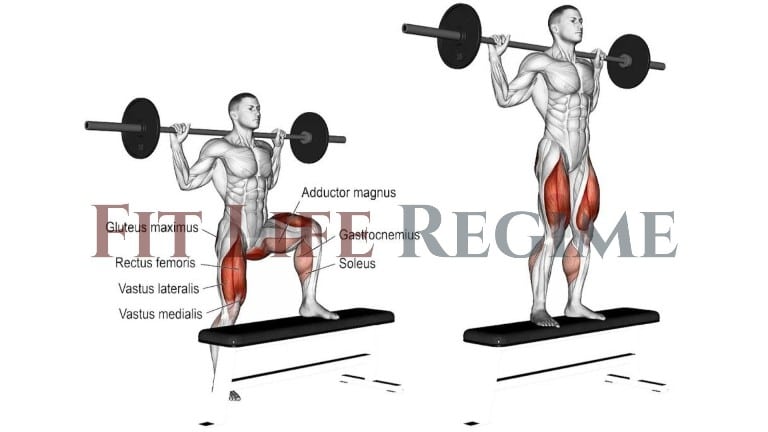
8. Side Lunge
The barbell lateral lunge is the best variation of the side lunge that people typically perform when they want a little more glute involvement with the movement pattern.
The unilateral movement of side lunges can help you to improve muscular imbalances, increase strength in each leg, and benefit from a functional movement.

9. Jefferson Squat
If you’re looking for a way to get more creative with your barbell leg workout, why not try Jefferson squats?
It is an old technique that you don’t see many people utilizing anymore, but it truly is an excellent workout because of the way that it tests and works your lower body.
It requires a balancing act (Asymmetrical movement). There’s an element of building up coordination and stabilization to keep the bar centered, which also helps to avoid injuries.

10. Barbell Lunges
You must do barbell lunges when doing leg workouts with the barbell, as it is a brilliant exercise that helps you strengthen your legs.
It is a power move to build Quadriceps and butt muscles. It develops balance, coordination, and your legs’ functional strength.

11. Barbell Hip Thrust
The barbell hip thrust is a popular exercise that is used to target the glutes and hamstrings for muscle and strength-building purposes.
Now, a lot of people are afraid to perform this movement or just not interested since it requires a little setup, and may even look a little funny.
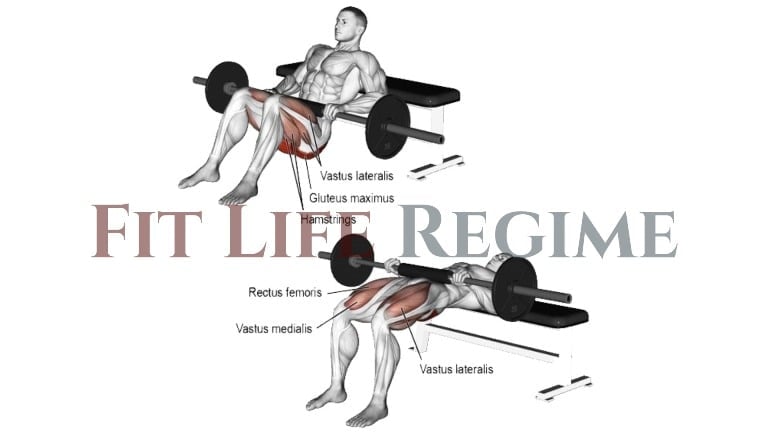
12. Barbell Box Squat
The box squat is a compound exercise that uses a barbell and a plyometric box to work for muscle groups throughout your body.
The posture of box squats puts slightly less pressure on your knee joints when compared to front squats or back squats.
This is a great exercise for learning how to squat because it reinforces the sitting-back portion of the squat. It is the best option for a beginner who is doing a barbell leg workout.

13. Landmine Squat
Are you tired of the same old squats in your workout routine? Looking for a new and challenging exercise to add to your leg day? Look no further than the landmine squat.
The Landmine Squat is an excellent power exercise to build quality thigh muscle mass. However, it requires more stabilizer muscles, including various back, shoulders, and chest muscles.
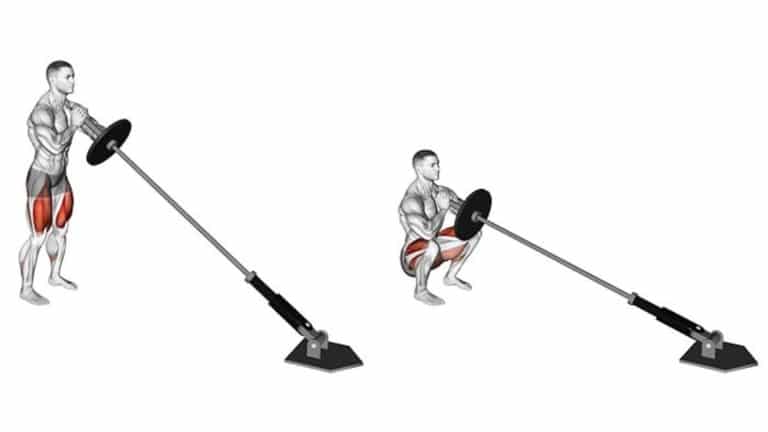
14. Landmine Hack Squat
The landmine hack squat, also known as landmine reverse squat, is a hybrid of the hack squat and landmine squat, which primarily targets the leg muscles while minimizing strain on the lower back.
It’s an excellent alternative if you’re looking to prioritize your quadriceps muscles in a relatively stable exercise and lack access to a hack squat machine.
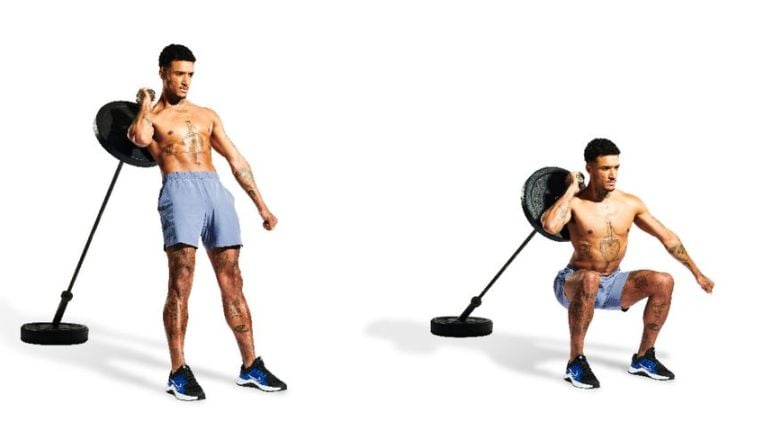
15. Landmine Sumo Squat
The landmine sumo squat is a type of squat where you position your feet wider than shoulder-width apart, typically twice as wide. This simple change significantly impacts the exercise mechanics and targeted muscles.
Some people find this squat more stable and comfortable than using a dumbbell, which requires balance and coordination to keep from swinging.
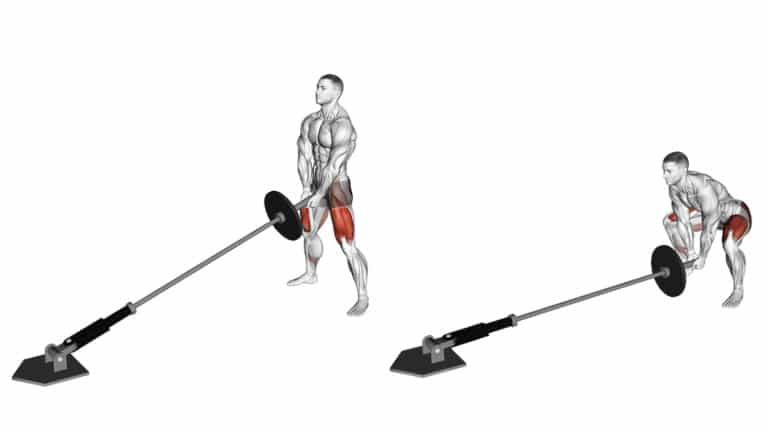
16. Barbell Standing Calf Raise
The barbell standing calf raise is a machine-based exercise targeting the muscles of the calves, particularly the gastrocnemius or upper calf muscle.
It is usually performed for moderate to high reps, such as 12–20 reps per set or more, as part of the lower body portion of a workout.
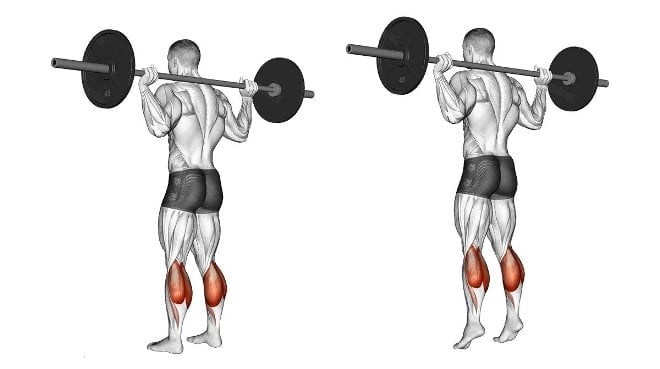
17. Barbell Seated Calf Raise
The barbell seated calf raise is one of the best strength-gaining exercises that targets your calf muscles and accelerates their growth.
It specifically activates and stresses the soleus calf muscle, and so the exercise is best performed by maintaining an angle of 90 degrees at the knees.
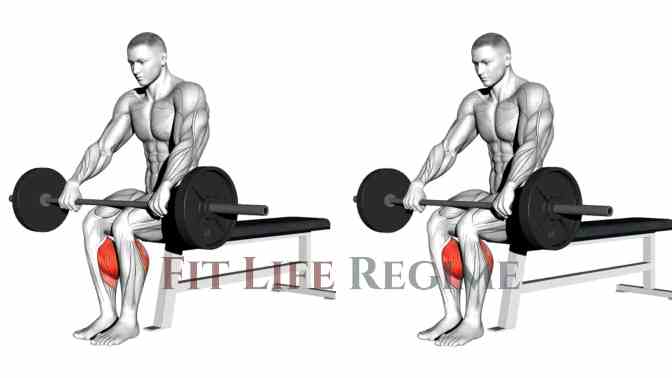
18. Barbell Hack Squats
The barbell hack squat is a variation of the traditional squat exercise.
Its primary focus is on the quadriceps; the barbell hack squat also engages the hamstrings and glutes, promoting balanced lower body development.
It involves holding a barbell behind your legs while performing a squatting motion.

Barbell Abs and Core Exercises Names
Chiseled, six-pack abs are made in the gym with intense training, not just the kitchen.
Barbells allow for weighted core movements to build an armor-plated midsection.
This list of killer barbell abs and core exercises will give you the raw power and sculpted definition to turn heads.
1. Barbell Rollout
The barbell rollout is an advanced abdominal exercise that uses a barbell to challenge your core stability and strength. It’s similar to an ab wheel rollout, but with a few key differences:
- A wider and more solid base makes it easier to control the movement.
- You can use more weight with a barbell to make the exercise harder.
- The barbell can be more difficult to grip than an ab wheel, which can engage your forearms and hands more.
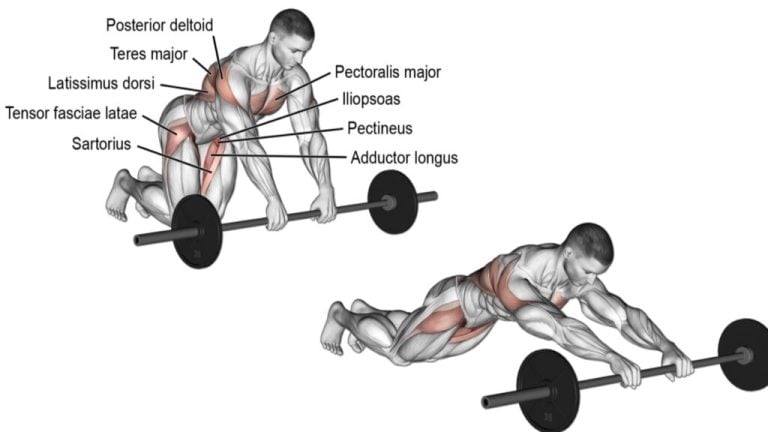
2. Landmine Twists
The Landmine twist is also known as landmine rotation, is extremely versatile and effective for building functional strength through all planes of motion, as well as packing on some serious muscle mass.
The Landmine Rotation is a great movement for strengthening the core and the shoulders.
It targets the deep muscles of the core, including both the obliques and the transversus abdominis.
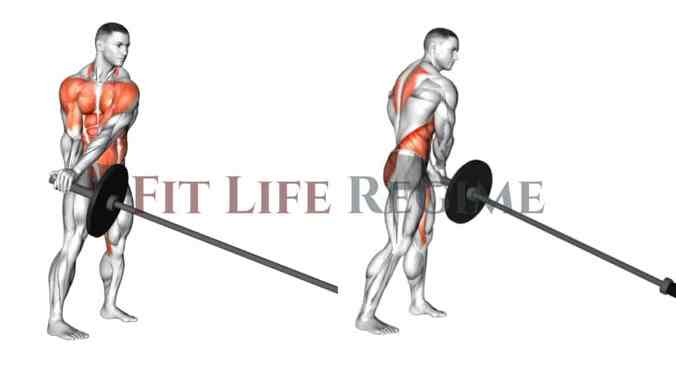
3. Standing Barbell Twist
The standing barbell twist is an advanced variation of the standing oblique twist, which targets the entire midsection, including the obliques. It also boosts strength and stability.
While primarily targeting the core, the landmine twist also works your shoulders and forearms to a lesser degree.
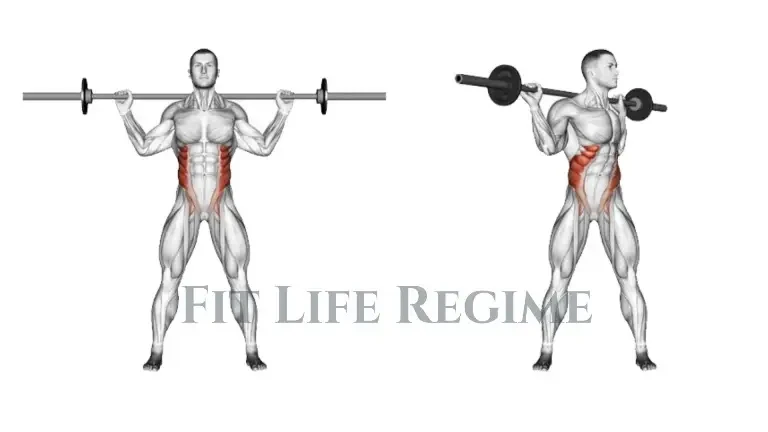
4. Barbell Side Bend
If you’re looking for an oblique exercise to include in your gym workout plan, practice barbell side bends.
Barbell side bend is a free weight and isolation exercises that works muscle groups on the side of your body—specifically the oblique muscles, and also targets the lower back.
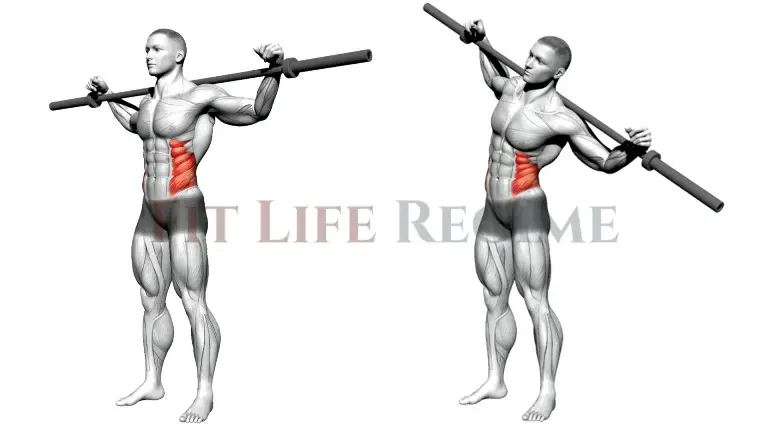
5. Overhead Barbell Side Bend
Overhead barbell side bend is an exercise that primarily targets the obliques
You can try out many different overhead side bend variations that may require different types of equipments, (dumbbell, resistance band, kettlebell) or even no equipment at all.

6. Barbell Sit Up
The barbell sit-up is a weighted variation of the traditional sit-up exercise that incorporates a barbell to enhance resistance.
When you hold the barbell steady above you, you engage not only your abs, but also your stabilizing muscles, improving overall core stability.
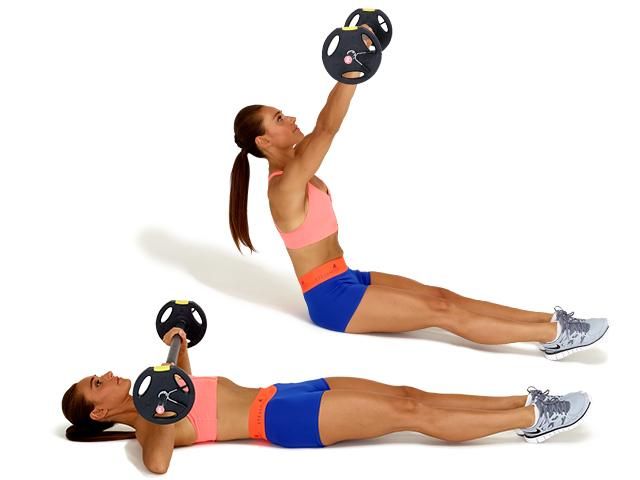
7. Barbell Suitcase Carry
The barbell suitcase carry is an exercise that targets the muscles of the core and forearms, and is a variation of the farmer’s carry.
The exercise involves holding a barbell in a neutral grip and standing up straight. Then, walk for a certain amount of time while keeping your shoulders up and holding the barbell by your side like a suitcase.
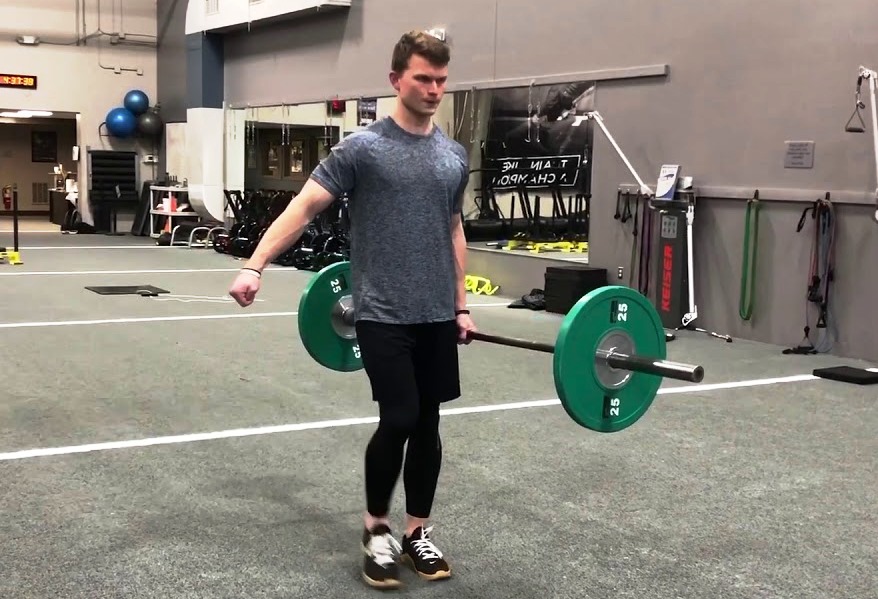
Conclusion
There are many ways to build, strengthen, and challenge every muscle group with over 100 barbell exercises.
The range is vast, from foundational barbell presses to unique variations like the Zercher squat and behind-the-back shrug.
With this diverse collection of barbell exercises that go beyond the basics, your entire body will experience unmatched increases in strength, size, and leanness.
Select your favorite barbell moves from the list and prepare for remarkable gains in muscularity, explosive power, and athletic capabilities.
The barbell’s versatility for progressive overload is unmatched. Master these exercises and prepare for new levels of physique development.

Manish is a NASM-certified fitness and nutrition coach with over 10 years of experience in weight lifting and fat loss fitness coaching. He specializes in gym-based training and has a lot of knowledge about exercise, lifting technique, biomechanics, and more.
Through “Fit Life Regime,” he generously shares the insights he’s gained over a decade in the field. His goal is to equip others with the knowledge to start their own fitness journey.
